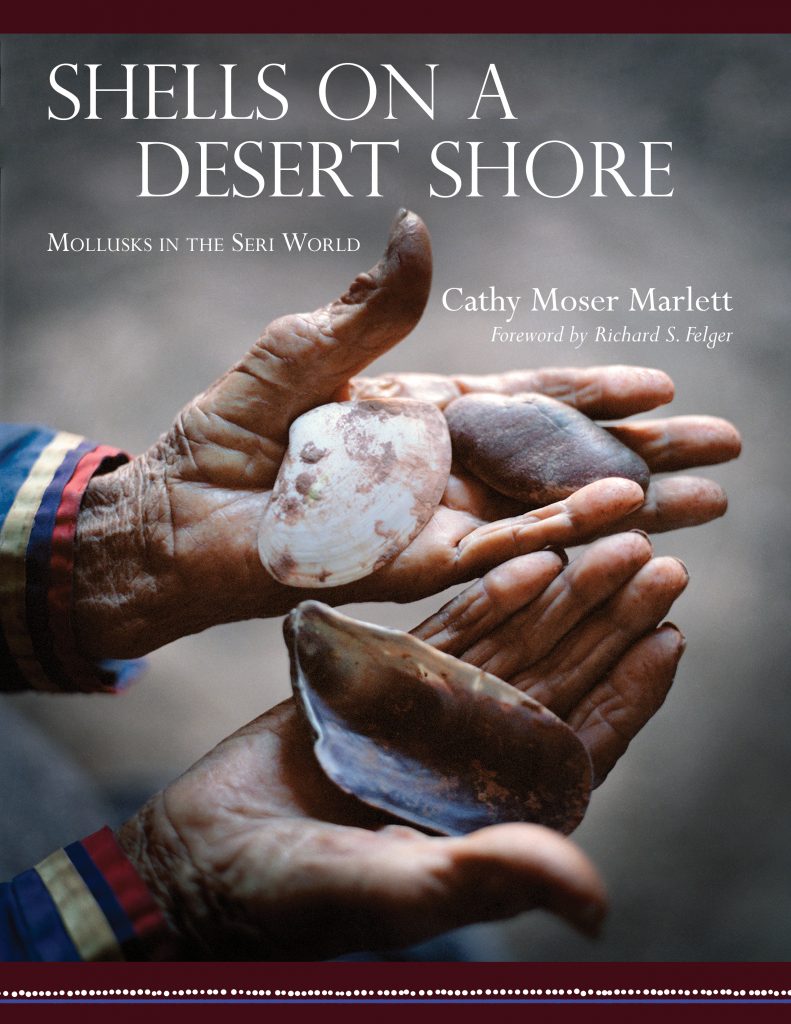Shells on a Desert Shore
Mollusks in the Seri World
Hardcover ($77.00), Ebook ($77.00)
Buy
In Mexico’s western Sonoran Desert along the Gulf of California is a place made extraordinary by the desert solitude, the dynamic sea, and the people who live there—the Seris. Central to the lives of these people are the sea and its shores.
Shells on a Desert Shore describes the Seri knowledge of mollusks and includes names, folklore, history, uses, and much more. Cathy Moser Marlett’s research of several decades, conducted in the Seri language, builds on work begun in 1951 by her parents, Edward and Becky Moser. The language, spoken by fewer than a thousand people today, is considered endangered. Marlett presents what she has learned from Seri consultants over recent decades and also draws from her own childhood experiences while living in a Seri village. The information from the people who had lived as hunter-gatherers provides a window into a lifestyle no longer recalled from personal experience by most Seris today—and perhaps a window into the lives of other peoples who made the Gulf’s shores their home.
The book offers a wealth of information about Seri history, as well as species accounts of more than 150 mollusks from the Seri area on the central Gulf coast. Chapters describe how the people ate mollusks or used them medicinally, how the mollusks were named, and how their shells were used. The author provides several hundred detailed drawings and photographs, many of them archival.
Shells on a Desert Shore is a fresh, original presentation of a significant part of the Seri way of life. Unique because it is written from the perspective of a participant in the Seri culture, the book will stand as a definitive, irreplaceable work in ethnography, a time capsule of the Seri people and their connection to the sea.
Shells on a Desert Shore describes the Seri knowledge of mollusks and includes names, folklore, history, uses, and much more. Cathy Moser Marlett’s research of several decades, conducted in the Seri language, builds on work begun in 1951 by her parents, Edward and Becky Moser. The language, spoken by fewer than a thousand people today, is considered endangered. Marlett presents what she has learned from Seri consultants over recent decades and also draws from her own childhood experiences while living in a Seri village. The information from the people who had lived as hunter-gatherers provides a window into a lifestyle no longer recalled from personal experience by most Seris today—and perhaps a window into the lives of other peoples who made the Gulf’s shores their home.
The book offers a wealth of information about Seri history, as well as species accounts of more than 150 mollusks from the Seri area on the central Gulf coast. Chapters describe how the people ate mollusks or used them medicinally, how the mollusks were named, and how their shells were used. The author provides several hundred detailed drawings and photographs, many of them archival.
Shells on a Desert Shore is a fresh, original presentation of a significant part of the Seri way of life. Unique because it is written from the perspective of a participant in the Seri culture, the book will stand as a definitive, irreplaceable work in ethnography, a time capsule of the Seri people and their connection to the sea.
“Essential reading for everyone interested in the Seri.”—E. N. Anderson, author of The Pursuit of Ecotopia: Lessons from Indigenous and Traditional Societies for the Human Ecology of Our Modern World
“This is the definitive work on Seri mollusks, a subject scarcely scratched by earlier Southwest ethnographers.”—Amadeo M. Rea, author of Wings in the Desert: A Folk Ornithology of the Northern Pimans
“This book represents the accomplishment of a life’s observations and intimate exchange of ideas with Seri collaborators and it surely is an important contribution to ethnobiology as a discipline.”—Ethnobiology Letters
“A delight for a Southwestern ethnobiologist or anthropologist.”—Economic Botany
“Ethnographic accounts of shellfishing are very rare and are regarded as something like comets in a star-dotted night sky. Cathy Marlett’s text on Seri ethnomalacology is such a comet.”—American Anthropologist
“A delight for a Southwestern ethnobiologist or anthropologist.”—Economic Botany
“Ethnographic accounts of shellfishing are very rare and are regarded as something like comets in a star-dotted night sky. Cathy Marlett’s text on Seri ethnomalacology is such a comet.”—American Anthropologist
 The University of Arizona Press
The University of Arizona Press

